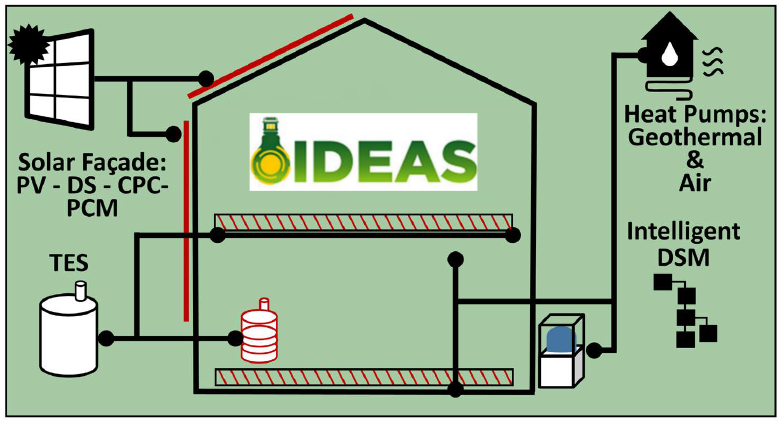Novel building Integration Designs for increased Efficiencies in Advanced climatically tunable renewable energy Systems
Buildings play a significant role in the global energy balance. Typically, they account for 20–30% of the total primary energy requirement of industrialized countries, 40% in the EU. Global buildings sector energy intensity fell by 1.3% per year between 2010 and 2014, thanks to continued adoption and enforcement of building energy codes and efficiency standards. Yet progress has not been fast enough to offset growth in floor area (3% per year globally) and increasing energy demand. Applying the proposed integrated renewable energy system (RES) to buildings is an important application for wider integration and deployment of renewable energy and to achieving our binding EU targets of a minimum 40% reduction in greenhouse gas emissions (GHG) by 2030.
Renewable energy systems often require more space than is practicable in the urban setting. Apartment blocks and offices have restricted roof space and surrounding building footprints, which mean that traditional solar and geothermal technologies space requirements are insufficient to meet the needs of the buildings’ energy needs. IDEAS brings together a number of efficiency and scale improvements to solar photovoltaic (PV), thermal and geothermal RES that will enable more energy efficiencies to be achieved using a smaller area. This will mean that buildings in urban settings will be able to have more of their energy needs met by sustainable sources.
IDEAS: Novel building Integration Designs for increased Efficiencies in Advanced climatically tunable renewable energy Systems will provide 100% renewable energy,reduce CO2 emission by 100%with any surplus kWh generated to be used within IDEAS system operation.
The IDEAS project will combine several renewable energy technologies including solar photovoltaic, solar thermal, thermal energy storage and geothermal and air source heat pump (HP) technology coupled with underfloor heating to create an innovative building-integrated RES. This will cost-effectively exceed current RES efficiencies, generating electricity, heat and cooling, and optimised for multifamily,public, and commercial buildings indifferent climatic conditions.The research aim is to create a novel low-cost building with an integrated RES, maximising the output which will be tuneable for different climatic conditions.This will be achieved through novel luminescent and geometric concentrator techniques, leading to current solar system efficiencies being exceeded electrically.Thermal enhancement will be achieved using enhanced organic phase change materials (PCM) with a passive biomimetic heat transfer mechanism to be used for heat storage and discharge. An electrically driven multi-source HP system will then use the main energy sources at building scale (waste heat from the system, air and ground), to provide the input to an integrated underfloor heating and hot water system. It will also manage the thermal energy storage. This building integrated RES will use advanced control techniques to maximise performance together with electrical and thermal/cooling self-sufficiency in the building.The technology will be optimised and demonstrated for use in multifamily residential buildings, commercial and public buildings.
With enhanced solar capture, the temperature of PV cells increases,having a detrimental effect on solar cell efficiency. This will be resolved through the use of PCM which regulates PV cell temperature, maintaining the high efficiency of the cells. The PCM heat sink will be designed biomimetically for enhanced heat management. This novel system will be upscaled and coupled to a heat pump for underfloor heating and hot water demand in the building. The project will deliver breakthroughs not only in solar PV efficiencies and thermal storage but also produce a unique building-integrated solution which can be tailored to different building functions and climatic regions.
More information here.

